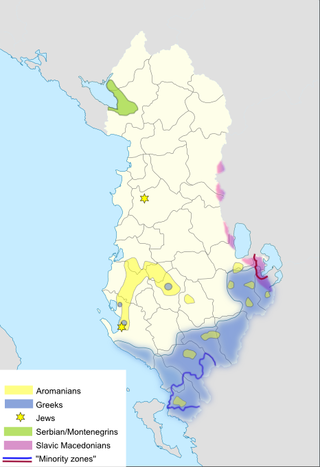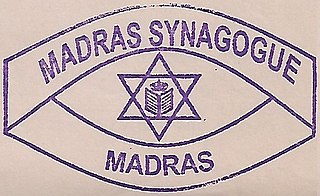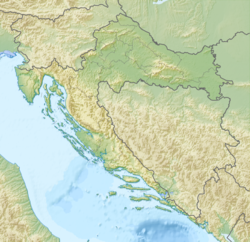
A synagogue, also called a shul or a temple, is a place of worship for Jews and Samaritans. It has a place for prayer where Jews attend religious services or special ceremonies such as weddings, bar and bat mitzvahs, choir performances, and children's plays. They also have rooms for study, social halls, administrative and charitable offices, classrooms for religious and Hebrew studies, and many places to sit and congregate. They often display commemorative, historic, or modern artwork alongside items of Jewish historical significance or history about the synagogue itself.

SephardicJews, also known as Sephardi Jews or Sephardim, and rarely as Iberian Peninsular Jews, are a Jewish diaspora population associated with the Iberian Peninsula. The term, which is derived from the Hebrew Sepharad, can also refer to the Jews of the Middle East and North Africa, who were also heavily influenced by Sephardic law and customs. Many Iberian Jewish exiled families also later sought refuge in those Jewish communities, resulting in ethnic and cultural integration with those communities over the span of many centuries. The majority of Sephardim live in Israel.

Marjan is a hill on the peninsula of the city of Split, the second largest city of Croatia. It is covered in a dense Mediterranean pine forest and completely surrounded by the city and the sea, making it a unique sight. Originally used as a park by the citizens as early as the 3rd century, it is a favorite weekend excursion destination and a recreational center for the city. It is also the setting for numerous beaches and jogging trails as well as tennis courts and the city Zoo, all surrounded by the scenic forest. The tip of the peninsula houses the Institute of Oceanography and Fisheries.

The Great Synagogue of Rome is an Orthodox Jewish congregation and synagogue, that is located at Lungotevere de' Cenci, in Rome, in Lazio, Italy. Designed by Vincenzo Costa and Osvaldo Armanni in an eclectic mix of Historicism and Art Nouveau styles, the synagogue was completed in 1904. It is the largest synagogue in Rome.
Spanish and Portuguese Jews, also called Western Sephardim, Iberian Jews, or Peninsular Jews, are a distinctive sub-group of Sephardic Jews who are largely descended from Jews who lived as New Christians in the Iberian Peninsula during the few centuries following the forced expulsion of unconverted Jews from Spain in 1492 and from Portugal in 1497. They should therefore be distinguished both from the descendants of those expelled in 1492 and from the present-day Jewish communities of Spain and Portugal.

Bevis Marks Synagogue, officially Qahal Kadosh Sha'ar ha-Shamayim, is an Orthodox Jewish congregation and synagogue, located off Bevis Marks, Aldgate, in the City of London, England, in the United Kingdom. The congregation is affiliated to London's historic Spanish and Portuguese Jewish community and worships in the Sephardic rite.

The West London Synagogue, abbreviated WLS, and fully the West London Synagogue of British Jews is a Reform Jewish congregation and synagogue, located near Marble Arch, at 34 Upper Berkeley Street, in the City of Westminster, in Central London, England, in the United Kingdom.
Italian Jews or Roman Jews can be used in a broad sense to mean all Jews living in or with roots in Italy, or, in a narrower sense, to mean the Italkim, an ancient community living in Italy since the Ancient Roman era, who use the Italian liturgy as distinct from those Jewish communities in Italy dating from medieval or modern times who use the Sephardic liturgy or the Nusach Ashkenaz.

The history of the Jews in Croatia dates back to at least the 3rd century, although little is known of the community until the 10th and 15th centuries. According to the 1931 census, the community numbered 21,505 members, and it is estimated that on the eve of the Second World War the population was around 25,000 people. Most of the population was murdered during the Holocaust that took place on the territory of the Nazi puppet state called the Independent State of Croatia. After the war, half of the survivors chose to settle in Israel, while an estimated 2,500 members continued to live in Croatia. According to the 2011 census, there were 509 Jews living in Croatia, but that number is believed to exclude those born of mixed marriages or those married to non-Jews. More than 80 percent of the Zagreb Jewish Community were thought to fall in those two categories.

The Sardis Synagogue is a former ancient Jewish synagogue, that was discovered in the modern-day town of Sardis, in the Manisa Province, in the Aegean Region of western Turkey. The former synagogue building is now an archaeological site and Jewish museum. The archaeological site is the largest Jewish site known from antiquity.

The Jewish people of Bosnia and Herzegovina are one of the minority peoples of Bosnia and Herzegovina, according to country's constitution. The history of Jews in Bosnia and Herzegovina spans from the arrival of the first Bosnian Jews as a result of the Spanish Inquisition to the survival of the Bosnian Jews through the Holocaust and the Yugoslav Wars. Judaism and the Jewish community in Bosnia and Herzegovina have one of the oldest and most diverse histories of all the former Yugoslav states, and is more than 500 years old, in terms of permanent settlement. Then a self-governing province of the Ottoman Empire, Bosnia was one of the few territories in Europe that welcomed Jews after their expulsion from Spain.

The Sarajevo Synagogue is an Orthodox Jewish congregation and synagogue, located on the south bank of the river Miljacka, in Sarajevo, in Bosnia and Herzegovina. The synagogue was constructed in 1902 and is the only functioning synagogue in Sarajevo today. The congregation worships in the Ashkenazi rite.

The history of the Jews in Malta spans two millennia. A Jewish community is attested on the islands by the 4th-5th century. Jews prospered in Malta under Arab and Norman rule. They were expelled in 1492, and a community could only re-establish itself after 1798 under British rule. In the 19th and 20th century, the Jewish community in Malta welcomed refugees from Italy and Central Europe, escaping Nazi rule. Today, a small community remains well established on the islands.

The history of the Jews in Albania dates back about 2,000 years. According to historian Apostol Kotani : "Jews may have first arrived in Albania as early as 70 C.E. as captives on Roman ships that washed up on the country's southern shores... descendants of these captives that would build the first synagogue in the southern port city of Sarandë in the fifth century...[but] Little is known about the Jewish community in the area until the 15th century."

Historic synagogues include synagogues that date back to ancient times and synagogues that represent the earliest Jewish presence in cities around the world. Some synagogues were destroyed and rebuilt several times on the same site. Others were converted into churches and mosques or used for other purposes.
The Sha'are Shalom Synagogue, officially the Kahal Kadosh Sha'are Shalom, also known as the United Congregation of Israelites, is a Reform Jewish congregation and synagogue, located in the city of Kingston, on the island of Jamaica.

The Bova Marina Synagogue is a former Jewish congregation and synagogue, that was located in Bova Marina, Calabria, Italy. It is the second oldest synagogue discovered in Italy and one of the oldest in Europe, dating from the 4th century CE. The former site of the synagogue has been an archaeological site since 1983.

The Lauderdale Road Spanish & Portuguese Synagogue, more commonly called the Lauderdale Road Synagogue, is an Orthodox Jewish congregation and synagogue, located in Maida Vale on Lauderdale Road in the City of Westminster, West London, England, in the United Kingdom.
Balkan Jews refers to Jews who live or lived in the Balkans.

The Madras Synagogue is the only synagogue in Chennai and it was built by Jacques (Jaime) de Paiva (Pavia) a Paradesi Jew of Chennai. Madras Synagogue was also known as the Esnoga, or Snoge, Esnoga is synagogue in Ladino, the traditional Judaeo-Spanish language of Sephardic Jews.


















